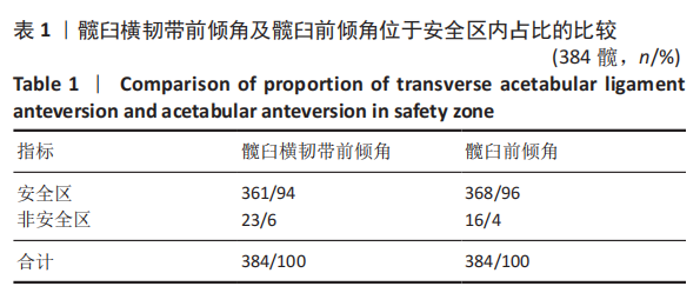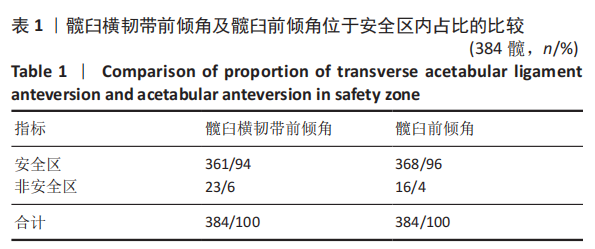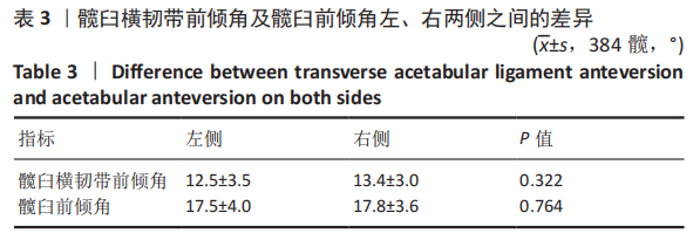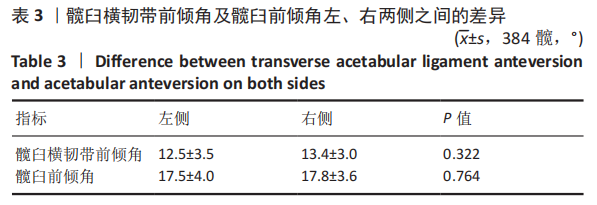[1] SNIJDERS TE, WILLEMSEN K, VAN GAALEN SM, et al. Lack of consensus on optimal acetabular cup orientation because of variation in assessment methods in total hip arthroplasty: a systematic review. Hip Int. 2019;29(1):41-50.
[2] SEAGRAVE KG, TROELSEN A, MALCHAU H, et al. Acetabular cup position and risk of dislocation in primary toTAL hip arthroplasty. Acta Orthop. 2017;88(1):10-17.
[3] ZHAO JX, SU XY, ZHAO Z, et al. Radiographic assessment of the cup orientation after total hip arthroplasty: a literature review. Ann Transl Med. 2020;8(4):130.
[4] JAIN S, ADERINTO J, BOBAK P. The role of the transverse acetabular ligament in total hip arthroplasty. Acta Orthop Belgica. 2013;79(2): 135-140.
[5] SALAL MH. Transverse acetabular ligament as an anatomical landmark for intraoperative cup anteversion in primary total hip replacement. J Coll Physicians Surg Pak. 2017;27(10):642-644.
[6] HIDDEMA WB, VAN DER MERWE JF, VAN DER MERWE W. The transverse acetabular ligament as an intraoperative guide to cup abduction. J Arthroplasty. 2016;31(7):1609-1613.
[7] LEE SH, JANG WY, CHOI GW, et al. Is the transverse acetabular ligament hypertrophied and hindering reduction in developmental dysplasia of hip? Arthroscopy. 2018;34(4):1219-1226.
[8] SEAGRAVE KG, TROELSEN A, MALCHAU H, et al. Acetabular cup position and risk of dislocation in primary total hip arthroplasty. Acta Orthop. 2017;88(1):10-17.
[9] OCHI H, BABA T, HOMMA Y, et al. Importance of the spinopelvic factors on the pelvic inclination from standing to sitting before total hip arthroplasty. Eur Spine J. 2016;25(11):3699-3706.
[10] LEWINNEK GE, LEWIS JL, TARR R, et al.Dislocations after total hip replacement arthroplasties. J Bone Joint Surg(Am). 1978; 60(2) :217.
[11] RITTMEISTER M, CALLITSIS C. Factors influencing cup orientation in 500 consecutive total hip replacements. Clin Orthop Relat Res. 2006;445: 192-196.
[12] BARTLEY VH. Analysis of fatal blunt trauma presenting at an areawide trauma center. Med J.1975;148(5):511-515.
[13] 韦革韩,赵秉诚,覃文报,等.髋臼横韧带定位髋臼假体前倾校正骨盆旋转[J]. 中华关节外科杂志(电子版),2019,13(4):473-479.
[14] GRIFfiN AR, PERRIMAN D, BOLTON C, et al. An In Vivo Comparison of the Orientation of the Transverse Acetabular Ligament and the Acetabulum. J Arthroplasty. 2014;29(3):574-579.
[15] VISTE A, CHOUTEAU J, TESTA R, et al. Is transverse acetabular ligament an anatomical landmark to reliably orient the cup in primary total hip arthroplasty? Orthop Traumatol Surg Res. 2011;97(3):241-245.
[16] YOON BH, HA YC, LEE YK, et al. Is transverse acetabular ligament a reliable guide for aligning cup anteversion in toTAL hip arthroplasty? A measurement by CT arthrography in 90 hips. J Orthop Sci. 2016;21(2): 199-204.
[17] 赵秉诚,覃文报.全髋关节置换术中髋臼假体准确定位的研究进展[J].中华关节外科杂志(电子版),2019,13(6):736-739.
|





